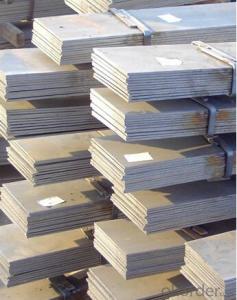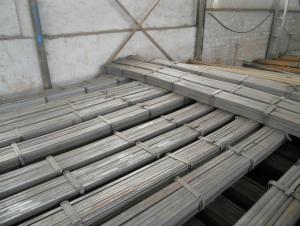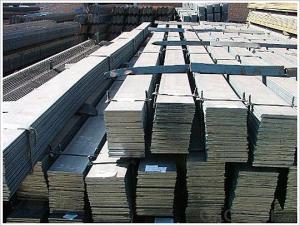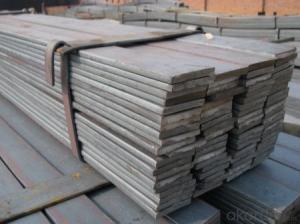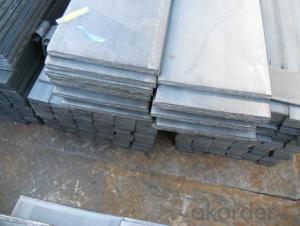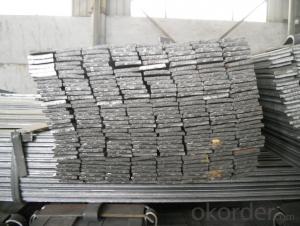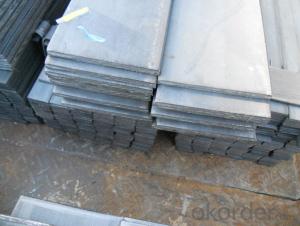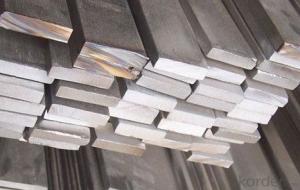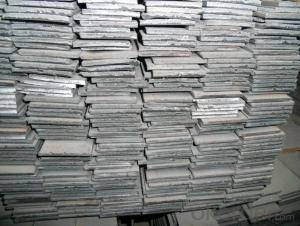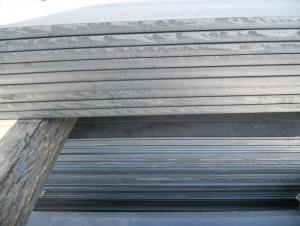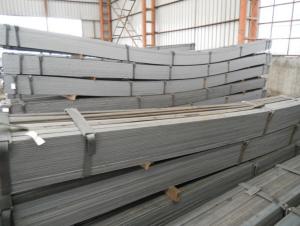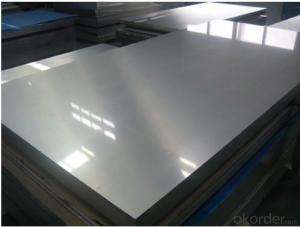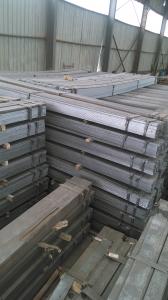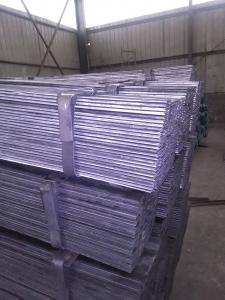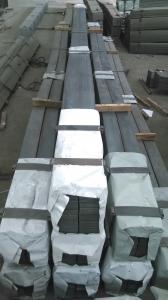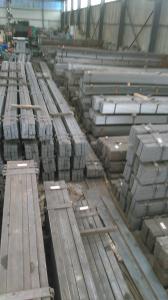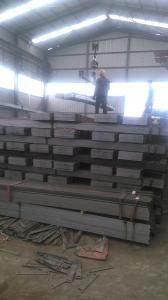Mild Carbon Steel Flat Bar
- Loading Port:
- China Main Port
- Payment Terms:
- TT or LC
- Min Order Qty:
- -
- Supply Capability:
- 10000 m.t./month
OKorder Service Pledge
OKorder Financial Service
You Might Also Like
Specification of Carbon Steel Flat Bar
Commodity: Carbon Steel Flat Bar
Standard: GB, JIS, ASTM,
Material: Q235, SS400 or Equivalent
Origin place: China
Thickness: 3mm-30mm
Width:20mm-200mm
Length: Max 12m
Certification: SGS/BV
Chemical composition of Q235
Alloy No | Grade | Element(%) | ||||
C | Mn | S | P | Si | ||
Q235 | B | 0.12—0.20 | 0.3—0.7 | ≤0.045 | ≤0.045 | ≤0.3 |
Physical properties of Q235
Alloy No | Grade | Yielding strength point(Mpa) | Tensile strength (Mpa) | Elongation after fracture(%) | ||||||
Thickness (mm) | Thickness (mm) | |||||||||
≤16 | >16--40 | >40--60 | >60--100 | ≤16 | >16--40 | >40--60 | >60--100 | |||
≥ | ≥ | |||||||||
Q235 | B | 235 | 225 | 215 | 205 | 375--500 | 26 | 25 | 24 | 23 |
Usage/Applications of Carbon Steel Flat Bar
Widely used for construction;
Machinery manufacturing;
Iron tower steel structure;
Shipbuilding; Steel grating;
Staircase;
Bridge;
Viaduct;
Railway spare parts;
Boilers making etc.
Packaging & Delivery of Carbon Steel Flat Bar
Packaging Details: The Steel Flat Bars are packed in bundles and loaded in 20 feet/40 feet container, or shipped by bulk cargo ,also we can do as customer's requirements.
Delivery Details:30~45 days upon the receipt of buyer payment by T.T. or L/C.
Production Flow of Carbon Steel Flat Bar
The Carbon Steel Flat Bar is made through three processes:
1.Feeding the material: Feeding the row material (the steel plate) to Slitting Line.
2.Slitting:The steel plate would be slitted into expected width by lengthways cutter.
3. Leveled and cutting: The plat bar would be ground into level by the grinder and then cut into required length.
FAQ:
Q1: What makes stainless steel stainless?
A1: Stainless steel must contain at least 10.5 % chromium. It is this element that reacts with the oxygen in the air to form a complex chrome-oxide surface layer that is invisible but strong enough to prevent further oxygen from "staining" (rusting) the surface. Higher levels of chromium and the addition of other alloying elements such as nickel and molybdenum enhance this surface layer and improve the corrosion resistance of the stainless material.
Q2: Can stainless steel rust?
A2: Stainless does not "rust" as you think of regular steel rusting with a red oxide on the surface that flakes off. If you see red rust it is probably due to some iron particles that have contaminated the surface of the stainless steel and it is these iron particles that are rusting. Look at the source of the rusting and see if you can remove it from the surface.
Q3: Why buy Materials & Equipment from OKorder.com?
A3: All products offered byOKorder.com are carefully selected from China's most reliable manufacturing enterprises. Through its ISO certifications, OKorder.com adheres to the highest standards and a commitment to supply chain safety and customer satisfaction.
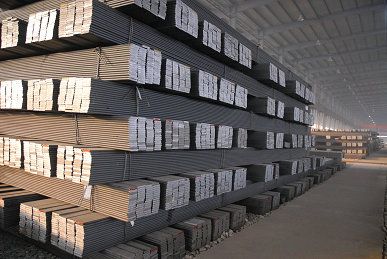
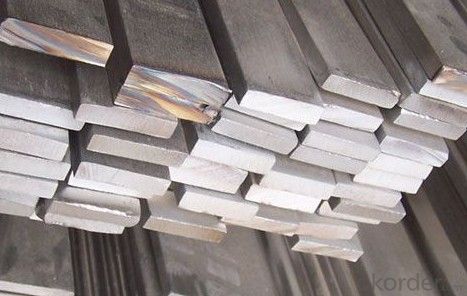
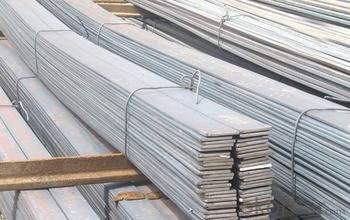
- Q: Can steel flat bars be used for manufacturing industrial equipment?
- Yes, steel flat bars can be used for manufacturing industrial equipment. Steel is a strong and durable material that is commonly used in the construction of industrial machinery due to its high tensile strength and resistance to wear and tear. Flat bars made of steel can be easily shaped, welded, and fabricated to create various components and structures required for industrial equipment.
- Q: Do steel flat bars have a specific tolerance range?
- Yes, steel flat bars do have a specific tolerance range. Tolerance refers to the acceptable deviation from the specified dimensions or properties of a product. In the case of steel flat bars, the tolerance range typically includes variations in thickness, width, and length. The specific tolerance range may vary depending on the manufacturing standards, grade of steel, and intended application of the flat bars. These tolerances are important to ensure the flat bars meet the required specifications and can be effectively used in various construction and industrial applications.
- Q: Are steel flat bars galvanized?
- No, steel flat bars are not typically galvanized. Galvanization is a process that involves coating steel with a layer of zinc to protect it from corrosion. While galvanization is commonly used for steel products, such as pipes or sheets, steel flat bars are usually left ungalvanized as they are primarily used for structural purposes rather than for protection against rust.
- Q: Can steel flat bars be used in earthquake-resistant structures?
- Yes, steel flat bars can be used in earthquake-resistant structures. Steel is known for its strength and ductility, making it a suitable material for withstanding seismic forces. Steel flat bars can be used in various structural elements, such as beams, columns, and braces, to provide stability and resistance against earthquakes.
- Q: What is the maximum length-to-height ratio for steel flat bars?
- The maximum length-to-height ratio for steel flat bars is typically around 20:1.
- Q: Lightning protection grounding, what is called three surface welding?
- When lap welding is adopted, the welding length is as follows:1, galvanized steel bar is not less than its width of 2 times, three surface welding. When the width of flat steel is different, the length of lap should be wide. Before laying, the flat steel should be adjusted straight, simmer, bend not to die, straight line should not be obvious bending, and should stand upright.2, galvanized round steel welding length of 6 times its diameter, and should be double-sided welding (when the diameter is not the same, the length of overlap in diameter should prevail).3, galvanized round steel and galvanized flat steel connection, its length is round steel diameter of 6 times.4, galvanized flat steel and galvanized steel pipe welding, in order to connect reliable, in addition to contact in itBoth sides of the site shall be welded, and the flat steel itself shall be bent in an arc to be welded with the steel pipe.
- Q: What are the standard packaging options for steel flat bars?
- The standard packaging options for steel flat bars typically include bundling them with steel straps or wrapping them in protective material such as plastic or paper, to ensure safe transportation and prevent damage or corrosion.
- Q: Can steel flat bars be used for making brackets or supports for electrical substations?
- Yes, steel flat bars can be used for making brackets or supports for electrical substations. Steel flat bars are known for their strength, durability, and load-bearing capacity, which makes them suitable for such applications. Additionally, steel is resistant to corrosion and can withstand harsh weather conditions, further enhancing its suitability for use in electrical substations.
- Q: How do you protect steel flat bars from weathering?
- There are various ways to safeguard steel flat bars from weathering. Applying a protective coating is a popular and effective method. This can be accomplished using paint, varnish, or a specialized metal coating that forms a barrier between the steel and the elements. The coating acts as a shield, preventing moisture from reaching the steel's surface and causing rust or corrosion. Prior to applying any coating, it is vital to ensure that the steel flat bars are devoid of dirt, grease, or existing rust. Thoroughly clean the surface using a degreaser and a wire brush or sandpaper to eliminate any loose rust or paint. Once the surface is clean and dry, the coating can be applied. Another approach to shield steel flat bars from weathering is through galvanization. This process involves coating the steel with a layer of zinc, which offers excellent corrosion resistance. Galvanization can be achieved through hot-dip galvanization, where the steel is submerged in a bath of molten zinc, or through electroplating, where a layer of zinc is applied using an electric current. Galvanized steel flat bars are highly resistant to moisture and atmospheric corrosion, making them ideal for outdoor applications. Aside from coatings and galvanization, proper storage and maintenance are also crucial for protecting steel flat bars from weathering. Storing them in a dry environment, away from direct exposure to rain or snow, can significantly extend their lifespan. Regular inspections and cleaning can help promptly identify and address any signs of rust or corrosion, preventing further damage. If any signs of weathering are detected, it is important to remove the affected area and reapply a protective coating to prevent further deterioration. By utilizing these methods and implementing appropriate preventative measures, steel flat bars can be effectively safeguarded from weathering, ensuring their longevity and durability.
- Q: How do steel flat bars contribute to the overall efficiency of healthcare structures?
- Several factors contribute to the overall efficiency of healthcare structures, and steel flat bars are a significant element in achieving this. Firstly, the utilization of steel flat bars in the construction of healthcare facilities is widespread due to their exceptional strength and durability. This ensures that the buildings can withstand the test of time and provide a secure and safe environment for patients, staff, and equipment. Moreover, the versatility of steel flat bars allows for easy fabrication into various shapes and sizes, enabling efficient and precise construction. This flexibility enables healthcare structures to be designed and constructed according to specific requirements, optimizing the utilization of space and resources. Additionally, the fire resistance properties of steel flat bars are of utmost importance in healthcare structures, where the safety of occupants is a priority. By incorporating steel flat bars into the construction process, healthcare facilities can effectively minimize the risk of fire incidents and ensure the protection of patients and staff. Furthermore, the high load-bearing capacity of steel flat bars is essential in healthcare structures that require support for heavy equipment and machinery. This enables the buildings to accommodate advanced medical technology and infrastructure, such as MRI machines, surgical equipment, and patient lifts, without compromising the structural integrity. Lastly, the low-maintenance nature and resistance to corrosion of steel flat bars result in reduced need for frequent repairs and replacements. This not only saves costs but also minimizes disruptions to healthcare services, allowing medical professionals to focus on delivering quality care to patients. In conclusion, steel flat bars play a vital role in enhancing the efficiency of healthcare structures by providing strength, versatility, fire resistance, load-bearing capacity, and low-maintenance characteristics.
Send your message to us
Mild Carbon Steel Flat Bar
- Loading Port:
- China Main Port
- Payment Terms:
- TT or LC
- Min Order Qty:
- -
- Supply Capability:
- 10000 m.t./month
OKorder Service Pledge
OKorder Financial Service
Similar products
Hot products
Hot Searches
Related keywords
